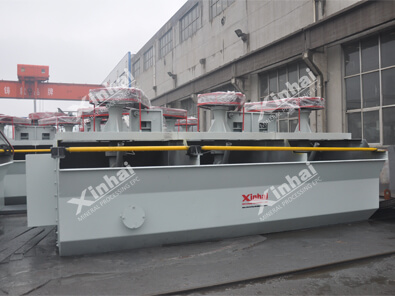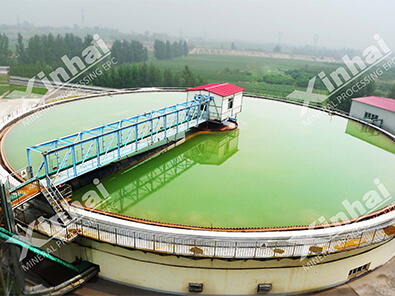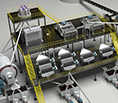The Complete Guide on How to Concentrate Lithium Ore
 Laura
Laura
 Nov 27, 2024
Nov 27, 2024
 1239
1239
If you want to know more details about equipment, solutions, etc, please click the button below for free consultation, or leave your requirements!

( Ore Production Line Setup )
Lithium has become a vital resource in today’s technology-driven world, primarily due to its crucial role in lithium-ion batteries used in electric vehicles and portable electronics. As the demand for lithium continues to grow, so does the need for efficient methods to concentrate lithium ore. This comprehensive guide will explore the essential processes, techniques, and considerations involved in lithium ore concentration, providing you with the knowledge needed to optimize extraction and production.
01Understanding Lithium Ore
Back1. What is Lithium Ore?
Lithium ore primarily consists of minerals that contain lithium, with the most significant being spodumene, lepidolite, and petalite. Spodumene, in particular, is favored for its high lithium content and is often the primary focus of lithium mining operations.
2. Importance of Concentration
Concentration is a critical step in the production of lithium. It involves separating lithium-containing minerals from the gangue (waste material) to produce a high-grade lithium concentrate. This process not only maximizes the recovery of lithium but also enhances the economic viability of mining operations.
02Overview of Lithium Ore Concentration Processes
Back1. Crushing and Grinding
The first step in concentrating lithium ore is to break it down into smaller particles to liberate the lithium minerals. This is typically done through a series of crushing and grinding processes.
Crushing: Large pieces of ore are crushed using jaw crushers or cone crushers. The goal is to reduce the ore size to a manageable level for further processing.
Grinding: The crushed ore is then ground in ball mills or rod mills to achieve finer particle sizes, which helps in liberating lithium minerals from the surrounding materials.
2. Concentration Techniques
Once the ore is sufficiently ground, various concentration techniques can be employed to separate the lithium minerals from the gangue. The most commonly used methods include:
A. Gravity Separation
Gravity separation exploits differences in density between lithium minerals and gangue materials. This method is particularly effective for coarse particles and can be achieved through:
Jigging: This process uses pulsating water to separate particles based on density.
Shaking Tables: These tables use a combination of gravity and motion to separate minerals by density.
B. Flotation
Flotation is one of the most widely used methods for concentrating lithium ore, especially for fine particles. The process involves adding chemicals (collectors, frothers) to a slurry of ground ore, which enhances the hydrophobic properties of lithium minerals. The steps include:
Preparation: The ore is ground and mixed with water to create a slurry.
Addition of Reagents: Chemicals are added to promote the attachment of lithium minerals to air bubbles.
Froth Formation: Air is injected into the slurry, creating bubbles that carry the lithium minerals to the surface, forming a froth.
Collection: The froth is skimmed off, containing concentrated lithium minerals.
C. Magnetic Separation
Magnetic separation can be effective in some cases, particularly when dealing with lithium ores that contain magnetic impurities. The process involves:
Magnetic Separator: A magnetic field is applied, attracting magnetic materials while allowing non-magnetic lithium minerals to pass through.
3. Leaching
For lithium minerals like spodumene, leaching is often employed to extract lithium after concentration. The typical leaching process includes:
Calcination: The concentrated spodumene is heated to a high temperature to convert it into a more soluble form.
Acid Leaching: The calcined material is treated with acid (e.g., sulfuric acid) to dissolve lithium, which can then be recovered through precipitation or crystallization.
03Key Considerations for Concentrating Lithium Ore
Back1. Ore Characteristics
Understanding the specific characteristics of the lithium ore being processed is crucial for selecting the appropriate concentration method. Factors to consider include:
Mineral Composition: The type and abundance of lithium minerals present can influence the choice of concentration technique.
Particle Size: The size distribution of ore particles can affect the efficiency of separation processes.
2. Environmental Considerations
Lithium concentration processes can have environmental impacts, which must be managed effectively. Key considerations include:
Waste Management: Proper disposal of tailings and waste materials is essential to minimize environmental damage.
Water Usage: Concentration methods often require significant water input, necessitating efficient water management practices.
3. Economic Factors
The economic viability of lithium ore concentration relies on several factors:
Operational Costs: Understanding the costs associated with different concentration methods is essential for profitability.
Market Prices: Fluctuations in lithium prices can impact the overall financial success of mining operations.
04Best Practices for Improving Lithium Ore Concentration
Back1. Optimize Process Parameters
To enhance the efficiency of lithium ore concentration, it is vital to optimize key process parameters, including:
Particle Size: Ensuring the ore is ground to the optimal size for the chosen concentration method can significantly impact recovery rates.
Reagent Dosage: Carefully managing the amounts of chemicals used in flotation can improve lithium recovery and concentrate quality.
2. Conduct Regular Testing
Regular testing of both the ore and the concentrate is crucial for maintaining quality and efficiency. Consider implementing:
Routine Assays: Regularly analyze samples for lithium content to ensure the concentration process is performing effectively.
Process Monitoring: Continuously monitor key parameters (e.g., pH, density) to identify and rectify any issues promptly.
3. Invest in Technology
Advancements in technology can greatly enhance lithium ore concentration processes. Staying updated on the latest innovations, such as:
Automation and Control Systems: Implementing advanced monitoring and control systems can lead to more efficient operations.
New Separation Technologies: Exploring new methods, such as sensor-based sorting, can improve recovery rates and reduce costs.
4. Train and Develop Workforce
A skilled workforce is essential for the successful operation of lithium ore concentration processes. Invest in:
Training Programs: Provide ongoing training for staff to ensure they are familiar with the latest techniques and technologies.
Safety Protocols: Emphasize safety training to protect workers in potentially hazardous environments.
05Conclusion
BackConcentrating lithium ore is a complex but crucial process in the production of lithium for various applications. By understanding the characteristics of lithium ore, exploring different concentration techniques, and implementing best practices, operators can maximize lithium recovery and enhance the economic viability of their operations. As the demand for lithium continues to grow, optimizing concentration processes will become increasingly important for meeting market needs and ensuring sustainable practices in the industry.
By following the insights and strategies outlined in this guide, you can improve your lithium ore concentration efforts and contribute to the expanding lithium market. Whether you are a seasoned professional or new to the field, the knowledge gained here will serve as a valuable resource for your future endeavors in lithium production.
Contact us and learn more about How to Concentrate Lithium Ore!
 +86 183 3575 8886
+86 183 3575 8886 pinklaurabao@gmail.com
pinklaurabao@gmail.com




 Message
Message Chat Now
Chat Now



















